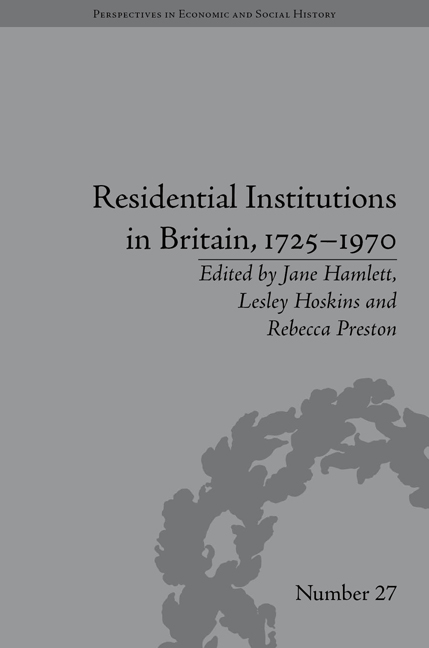Book contents
- Frontmatter
- Contents
- Acknowledgements
- List of Contributors
- List of Figures
- Introduction
- 1 Viewing the Early Twentieth-Century Institutional Interior through the Pages of Living London
- 2 ‘French Beef was Better than Hampstead Beef’: Taste, Treatment and Pauperism in a London Smallpox Hospital, 1871
- 3 From Asylum to Mental Hospital: Gender, Space and the Patient Experience in London County Council Asylums, 1890–1910
- 4 Refuge or Prison? Girls' Experiences of a Home for the ‘Mentally Defective’ in Scotland, 1906–1948
- 5 Paupers and their Experience of a London Workhouse: St Martin-in-the-Fields, 1725–1824
- 6 ‘A Veritable Palace for the Hard-Working Labourer?’ Space, Material Culture and Inmate Experience in London's Rowton Houses, 1892–1918
- 7 ‘The Place was a Home from Home’: Identity and Belonging in the English Cottage Home for Convalescing Psychiatric Patients, 1910–1939
- 8 ‘The Father and Mother of the Place’: Inhabiting London's Public Libraries, 1885–1940
- 9 ‘Discipline with Home-Like Conditions’: The Living Quarters and Daily Life of the Women's Army Auxiliary Corps in First-World-War Britain and France
- 10 Halls of Residence at Britain's Civic Universities, 1870–1970
- Notes
- Index
Introduction
- Frontmatter
- Contents
- Acknowledgements
- List of Contributors
- List of Figures
- Introduction
- 1 Viewing the Early Twentieth-Century Institutional Interior through the Pages of Living London
- 2 ‘French Beef was Better than Hampstead Beef’: Taste, Treatment and Pauperism in a London Smallpox Hospital, 1871
- 3 From Asylum to Mental Hospital: Gender, Space and the Patient Experience in London County Council Asylums, 1890–1910
- 4 Refuge or Prison? Girls' Experiences of a Home for the ‘Mentally Defective’ in Scotland, 1906–1948
- 5 Paupers and their Experience of a London Workhouse: St Martin-in-the-Fields, 1725–1824
- 6 ‘A Veritable Palace for the Hard-Working Labourer?’ Space, Material Culture and Inmate Experience in London's Rowton Houses, 1892–1918
- 7 ‘The Place was a Home from Home’: Identity and Belonging in the English Cottage Home for Convalescing Psychiatric Patients, 1910–1939
- 8 ‘The Father and Mother of the Place’: Inhabiting London's Public Libraries, 1885–1940
- 9 ‘Discipline with Home-Like Conditions’: The Living Quarters and Daily Life of the Women's Army Auxiliary Corps in First-World-War Britain and France
- 10 Halls of Residence at Britain's Civic Universities, 1870–1970
- Notes
- Index
Summary
Inhabiting Institutions: Inmates and Environments
When Brian Lunn wrote his memoirs in the late 1940s, the story of his life revealed his progress through a series of institutions. Lunn was born in 1893, the son of a wealthy businessman, and his family (whose business later became the travel firm Lunn Poly) lived in a town house in Bloomsbury, London. Lunn's first experience of institutional life was a prep school, which was swiftly followed by a scholarship to Westminster – where he fell out of favour with the other boys by boasting about his brothers at Harrow. In 1912, as was usual for young men of his background, he went up to Christ Church, Oxford. But, before he could graduate, the First World War intervened and he volunteered for the army: ‘While I felt that the war was futile, I felt that it was merely a specialised or intensified form of the futility of life’. According to the autobiography, in 1916 Lunn was posted from Catterick Camp in Yorkshire to Mesopotamia, where these feelings were exacerbated, and his mental health quickly deteriorated. He was moved first to the Royal Victoria Military Hospital, Netley, where his ‘room overlooked a garden; the winter shrubs and trees, and the winter smell of mould reminded me of staying in some house in the English country many years before’. He then transferred to Latchmere House, a military mental hospital for officers converted from a Victorian mansion, at Richmond in Surrey.
- Type
- Chapter
- Information
- Residential Institutions in Britain, 1725–1970Inmates and Environments, pp. 1 - 16Publisher: Pickering & ChattoFirst published in: 2014

